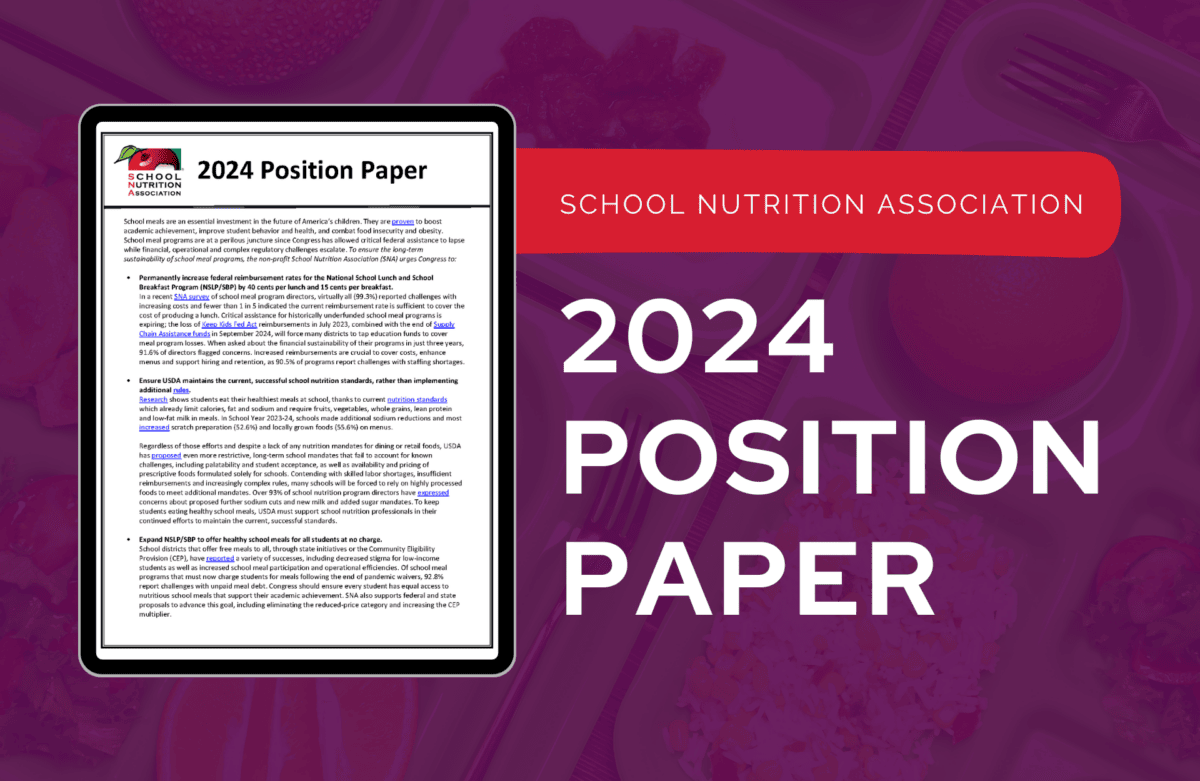UPDATE: On April 24, 2024, USDA released a final rule establishing long-term school nutrition standards. The final rule reflects feedback and concerns raised in SNA’s Position Papers. SNA’s press release on the rule expressed appreciation to USDA for establishing more attainable, long-term goals and urged Congress to provide necessary funds to address challenges and ensure school meal programs can successfully implement the rules.
School meals are an essential investment in the future of America’s children. They are proven to boost academic achievement, improve student behavior and health, and combat food insecurity and obesity. School meal programs are at a perilous juncture since Congress has allowed critical federal assistance to lapse while financial, operational and complex regulatory challenges escalate. To ensure the long-term sustainability of school meal programs, the non-profit School Nutrition Association (SNA) urges Congress to:
- Permanently increase federal reimbursement rates for the National School Lunch and School Breakfast Program (NSLP/SBP) by 40 cents per lunch and 15 cents per breakfast.
In a recent SNA survey of school meal program directors, virtually all (99.3%) reported challenges with increasing costs and fewer than 1 in 5 indicated the current reimbursement rate is sufficient to cover the cost of producing a lunch. Critical assistance for historically underfunded school meal programs is expiring; the loss of Keep Kids Fed Act reimbursements in July 2023, combined with the end of Supply Chain Assistance funds in September 2024, will force many districts to tap education funds to cover meal program losses. When asked about the financial sustainability of their programs in just three years, 91.6% of directors flagged concerns. Increased reimbursements are crucial to cover costs, enhance menus and support hiring and retention, as 90.5% of programs report challenges with staffing shortages. Learn more
- Ensure USDA maintains the current, successful school nutrition standards, rather than implementing additional rules.
Research shows students eat their healthiest meals at school, thanks to current nutrition standards which already limit calories, fat and sodium and require fruits, vegetables, whole grains, lean protein and low-fat milk in meals. In School Year 2023-24, schools made additional sodium reductions and most increased scratch preparation (52.6%) and locally grown foods (55.6%) on menus.
Regardless of those efforts and despite a lack of any nutrition mandates for dining or retail foods, USDA has proposed even more restrictive, long-term school mandates that fail to account for known challenges, including palatability and student acceptance, as well as availability and pricing of prescriptive foods formulated solely for schools. Contending with skilled labor shortages, insufficient reimbursements and increasingly complex rules, many schools will be forced to rely on highly processed foods to meet additional mandates. Over 93% of school nutrition program directors have expressed concerns about proposed further sodium cuts and new milk and added sugar mandates. To keep students eating healthy school meals, USDA must support school nutrition professionals in their continued efforts to maintain the current, successful standards. Learn More
- Expand NSLP/SBP to offer healthy school meals for all students at no charge.
School districts that offer free meals to all, through state initiatives or the Community Eligibility Provision (CEP), have reported a variety of successes, including decreased stigma for low-income students as well as increased school meal participation and operational efficiencies. Of school meal programs that must now charge students for meals following the end of pandemic waivers, 92.8% report challenges with unpaid meal debt. Congress should ensure every student has equal access to nutritious school meals that support their academic achievement. SNA also supports federal and state proposals to advance this goal, including eliminating the reduced-price category and increasing the CEP multiplier. Learn More

Category
Resource Type
Year Added
2024

